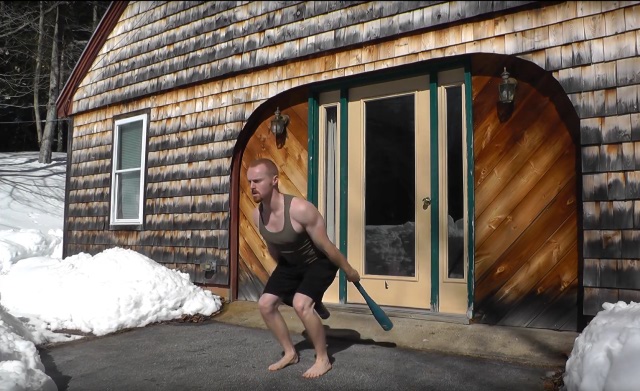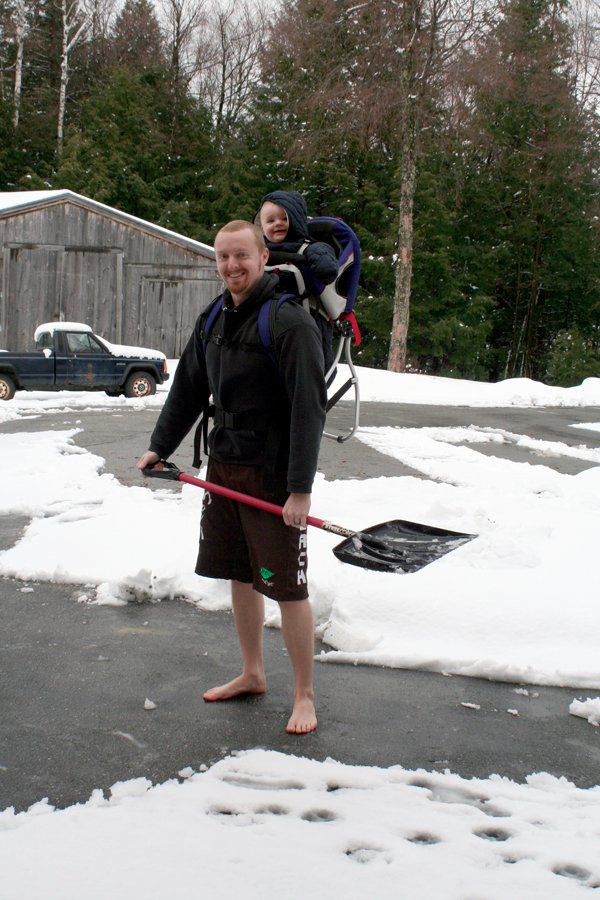
QUESTION: Hello John, thank you so much for always be so nice about answering my emails. After the last email you wrote me and researched a little bit more and realized I really needed a coach so now I am working with [name redacted], she is helping me with online training, I work out for a couple of weeks and then we have a skype session for questions, etc.
But I have a question for you that I think you will be able to help me with. When I started King of Clubs I lived in a big house but now I just moved to a small apartment so I can’t train indoors anymore. I live in Boston and the weather is getting tougher and tougher for training outside, especially very early in the morning or very late at night, the times of the day when I work out, but for now I have no choice. I wanted to ask you about training in cold weather (I can tell by some of your videos you have experience with that). Do you do any extra mobility for getting ready? Do you use gloves for the clubs? Do you think is somehow unsafe to work on low temperatures, lets say, below 30 or so?
As always thank you very much for your time reading and answering my emails,
-Adrian
ANSWER:
I have to laugh when my relatives from sunny California come up to New Hampshire for a visit, and they’re dressed for the Arctic Circle when it’s a balmy 60 degrees outside. And then they continually insist that “it’s freezing up here!”
Nope. It’s just different, and we’re more accustomed to it than they are. Some of us even like it.
And get this. ‘Round here, we train year round. Yes, that includes winter. And yes, it gets cold up here in New England. Sub-freezing temperatures are the norm, as is lots of snow. Every year is different, but we usually have a few weeks that are brutally cold, often in January.
But the show must go on! And sometimes, that means training in the cold – something I’ve been acquainted with for most of my life. And so, today, I thought I’d share some of my tips for making peace with the cold.
1) It’s just cold.
And that’s okay. Your body can handle a lot more than you probably think it can. You’re tougher than you think. So, act the part.
That said, deliberately exposing yourself to extreme temperatures does come with some risks. Case in point: I met a barefoot runner from Boston who insisted on going for a run every morning one winter. Yes, completely barefoot – in freezing rain, snow, and all temperatures. And he was committed to doing this every day, all winter. Long story short: he lost a toe due to frostbite. Since we met at a barefoot running workshop, I can verify that he was missing at least one toe (i.e. I saw the nub).
So, yes, there are very real dangers associated with prolonged exposure to the elements, like frostbite, hypothermia, or just pulling a hamstring. And most of these things can be easily prevented with some basic preparation. So, use common sense, but don’t overthink it. Your body was made to endure the cold. Speaking of which…
2) Adapt with the seasons.
If you’re going to be training outdoors or in a cold garage (etc.) during the winter months, start doing so as early in the season as you can. Your body will adapt to the cooler temperatures if you regularly expose yourself to them. And ideally, this will happen gradually over the course of several weeks (i.e. as the seasons change) leading up to winter. Up here in New England, we call this, “letting your Winter blood move in.” Making a sudden transition to colder temperatures will be much harder to adjust to. So, get into the habit early – before it gets frigid.
3) Wear the right clothing.
 If you’re only going to be training in the cold for a short period of time (e.g. less than 20 minutes), then your clothing choice isn’t super-important (unless it is extremely cold, or if you add “wet” to the cold). It’s not uncommon for me to hop outside to perform part of my workout in little more than a T-shirt. And I have also been spotted shoveling my driveway in shorts and barefoot.
If you’re only going to be training in the cold for a short period of time (e.g. less than 20 minutes), then your clothing choice isn’t super-important (unless it is extremely cold, or if you add “wet” to the cold). It’s not uncommon for me to hop outside to perform part of my workout in little more than a T-shirt. And I have also been spotted shoveling my driveway in shorts and barefoot.
Now, that said, if you’re going to be in very cold conditions or outdoors for upwards of thirty minutes, you’ll probably want to dress in layers and cover your extremities. You’ll just have to gauge the intensity of the cold (and wetness, wind chill, etc.) and your individual tolerance level, and dress appropriately.
Fun fact: if it’s not too cold for gloves, it’s not too cold for shoes either!
I recommend approaching it like any outdoorsman would. Wear a moisture-wicking base layer (e.g. polyester long johns), then an insulating layer over that (e.g. fleece or any other loose-fitting exercise clothing), and finally a wind/waterproof layer, if necessary. Finally, if the temps are really cold, wear a hat (or ski mask) and gloves. Personally, I don’t like training with gloves, but when the temps are too low, they are a welcome addition. You can always wear them while you rest and take them off when it’s go time.
Finally, do your best to keep your hands, feet, and head dry. Oh, and don’t over-dress. The last thing you want is to be sweating like a pig when it’s below freezing outside. Speaking of which, with a layering system, you can always remove layers once you warm up.
So, getting a quality hat or balaclava, gloves, and moisture-wicking base layers (including socks) is money well-spent.
And remember…There is no such thing as bad weather, only bad clothing.
4) Extend your warmups.
When you are cold, your blood tends to leave your extremities and head for your core. That means there’s less blood in your arms and legs when you’re cold. So, you’ll be a little stiffer, and more prone to injuries (e.g. pulling, straining, or tearing a muscle).
So, always perform a thorough warmup prior to training hard in the cold. You don’t just need to lube up the working joints and prime the muscles, you also need to raise your body temperature, which will take a little longer if you can’t feel your fingers.
Note: if possible, you can start your warmup indoors where it’s warmer.
A good rule of thumb for warmups is to do some joint mobility exercises for all of your major joint complexes, with particular attention paid to the joints you’ll be using the most during that workout (e.g. mobilize those hips if you’ll be doing squats). Also, perform some warmup sets of all the exercises you’ll be doing that day. Most people should be doing this anyway, but it’s even more important when it’s cold. And you may want to do an extra set or two before you start cranking up the effort.
Speaking of which, a proper warmup will not only raise your body temp, but it will also make you sweat. So, you should…
5) Drink plenty of fluids.
Hydration is important regardless of the season, but cold weather can suppress the feeling of thirst. So, make sure that you stay on top of your water intake. And while you’re training, make sure that you’re drinking water, too, even if you don’t feel particularly thirsty. Just keep sipping.
You can also warm up your water bottle before you train so that it’s not ice cold by the end of your workout.
6) Set realistic expectations for your performance and go easy on the hardcore stuff.
All other things remaining equal, you will perform better in a temperate environment than a cold one simply because the cold wears you out faster than usual. So, needless to say, you probably won’t be setting any major PRs when it’s frigid outside.
Also, you’ll need to be extra careful with any high intensity training like heavy weightlifting, plyometrics, weight swinging (e.g. kettlebells or clubbells, etc.) or any other high intensity training, for that matter (e.g. tabata, sprints, etc.) since these are more likely to result in a muscle injury (e.g. pull, strain, or tear) when you’re cold.
7) Make friends with the cold.
That is, get comfortable with being uncomfortable. Embrace hardship, and don’t let a little cold stop you from training in the winter months. In the same breath, there’s a fine line between being tough and being dumb. So, if your hands or feet (or head) start going numb, be very careful! You don’t want to be lifting weights with partial feeling in your hands, or running with partial feeling in your feet. That can become a very dangerous situation quickly. So, see point one above and use common sense.
And if you find that you have a strong aversion to being cold, consider facing that fear head-on. Try taking cool showers, or simply turn the water to cold for 15-30 seconds at a time. There are many benefits to cold exposure, and you can build up your tolerance gradually.
Note: I rarely bring my camera outdoors in the winter, but if you’re looking for some inspiration, Ross Enamait posted a cool video of him doing some winter training…
Wrap-up
And of course, the other usual recommendations apply, like getting enough sleep, eating well, using good technique, avoiding pain, etc. Remember that the less-ideal your training environment is, the more that the little details start to matter.
So, is training in the cold safe?
Well, if you take the proper precautions, then yes, training in the cold can be very safe. Plus, it can teach us many things. And it builds character, too, which is something everyone needs to achieve extraordinary health and fitness.
So, don’t use winter for hibernation. Get out there and get it done! Of course, a little cold isn’t going to stop the likes of you, is it?
If you found this article helpful, please share it with your friends:
.jpg)
![]()
Health-First Fitness Coach
P.S. If you liked this post, then please signup for the newsletter, or follow me on Facebook or Twitter for daily updates and other interesting info.